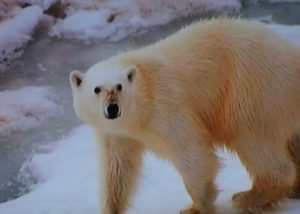 Katherine Burlake always wanted to be a writer but had no idea most of her published work would be in different publications, magazines and periodicals. Below is a short story written after visiting Svalbard Island that captures what she learned about the area through the eyes of a local biologist as he navigates the icy waters.
Katherine Burlake always wanted to be a writer but had no idea most of her published work would be in different publications, magazines and periodicals. Below is a short story written after visiting Svalbard Island that captures what she learned about the area through the eyes of a local biologist as he navigates the icy waters.
The Last Polar Bear
By Katherine Burlake
Svalbard Island, covered with snow-capped peaks and glaciers, is one of the last wilderness areas in the world. An isolated arctic island archipelago the size of West Virginia and governed by Norway, it is often featured on electronic route maps of commercial jets flying between North America and Europe. Snow and sea ice once stretched five hundred miles from the North Pole to the island. Today, the ice melts by late summer trapping polar bears that arrive on ice floes hunting seals. The life of a polar bear is a search for food to survive until the ice returns.
 The sound of the engine was nearly mute in the glacial mountains surrounding Hornsund Fjord. Looking up, he understood why the Dutch, one of the first explorers of the island, called it the land of pointed mountains. The man pushed aside memories of other trips up the sound and thought about the question the team sought to answer on this one: do polar bears survive trapped on the island? He locked the wheel and scanned the graveled beach ahead. His team’s search of the fjords and mountains by plane found no evidence of polar bears. A bear could be napping in a mountain crevasse and never be seen by his crew. The boat was slower but offered more opportunities for sightings. He was looking for frozen ice, or ice floes, essential for the survival of polar bears to hunt seals. Where was the ice? Had global warming caused the climate to change?
The sound of the engine was nearly mute in the glacial mountains surrounding Hornsund Fjord. Looking up, he understood why the Dutch, one of the first explorers of the island, called it the land of pointed mountains. The man pushed aside memories of other trips up the sound and thought about the question the team sought to answer on this one: do polar bears survive trapped on the island? He locked the wheel and scanned the graveled beach ahead. His team’s search of the fjords and mountains by plane found no evidence of polar bears. A bear could be napping in a mountain crevasse and never be seen by his crew. The boat was slower but offered more opportunities for sightings. He was looking for frozen ice, or ice floes, essential for the survival of polar bears to hunt seals. Where was the ice? Had global warming caused the climate to change?
To survive, polar bears must eat seals. Catching seals is a tricky business and sets the polar bear apart as one of the most intelligent mammals. They sit hunched over like old fishermen on ice holes for hours or even days, waiting for a seal to appear. Their eating cycle is feasting and fasting. Was that a polar bear on the ridge above the beach? He couldn’t be sure. They move rapidly and blend into the ice. What amazed him was the distance they could cover. He kept his eyes on the far end of the ridge to see if anything moved. Nothing!
In past years, the crystal blue-green waters of the fjord were filled with pack ice. The Arctic ice floes improve the survival rate of ringed seals that breed in the fjord. The ice protects the seal pups from predators and keeps the pups and mother together. The ice floes need to be large for seals to cut breathing holes in the ice. Using the sharp claws on their flippers, they cut between ten and fifteen breathing holes and, amazingly, keep them open all year. Only ringed seals use ice holes which could be why they are the bear’s favorite food. Polar bears will eat other seals, but ice floes make catching a seal easier.
 Polar perch and crustaceans fill the fjord’s water and are a feast not only for ringed seals, but also harbour seals and bearded seals. Polar bears only eat the liver of the seal, and Arctic foxes follow them to eat what remains. No one is sure why they only eat the liver. The man smiled, it wasn’t as if you could ask the bear.
Polar perch and crustaceans fill the fjord’s water and are a feast not only for ringed seals, but also harbour seals and bearded seals. Polar bears only eat the liver of the seal, and Arctic foxes follow them to eat what remains. No one is sure why they only eat the liver. The man smiled, it wasn’t as if you could ask the bear.
Local officials repeatedly told the team there were several thousand polar bears on the island. He thought the number was exaggerated to allow commercial interests like mining to continue unabated. On trips ashore, his team often found polar bear cubs and Arctic foxes, both endangered species having died of starvation. To him, this was proof the polar bear might not survive.
Years ago he spent a summer surveying polar bears in this fjord. From a distance, he watched single males and females with cubs roaming the ridges eating berries, raiding bird nests for eggs, and hunting seals. If they caught his scent, they immediately marched off across the tundra. Even with cubs, a mother walks rapidly, her low, plodding gait covering over two kilometers an hour, about half the speed of a male bear. Whalers in the twentieth century called the polar bear “the farmer” because of his pigeon-toed gait.
A century ago, coal mining was a major industry, but today the mines are in ruins. With the ice gone, mining could again be profitable. He wondered if the polar bear was curious about the boats going up to the mines. Did the polar bear get angry if boats broke up their hunt for seals? The bears usually stayed away from man. That, he thought, is another indication of their intelligence. Several times he watched bears slowly creep out onto a thin piece of ice. One time a clever bear stretched out his body to distribute it across the ice. This is a necessary and skilled move on thin ice for males weighing from 750 to 1500 pounds. Females tend to be much smaller at 350 to 500 pounds.
He jumped at the sound of cracking … continue reading
======================================
The pictures featured in this story were taken by the author as she experienced the fjord by boat.
